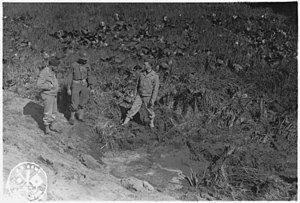unknown Tagami Meiji Date 21 June 1942 | Minor damage None | |
 | ||
Results Indecisive, Japanese retreat successful Similar Lookout Air Raids, World War II, Bombardment of Ellwood, Operation Tiderace, Marshalls–Gilberts raids | ||
Japanese attack oregon bombardment of fort stevens
The Bombardment of Fort Stevens occurred in June 1942, in the American Theater of the Pacific Theater of World War II. An Imperial Japanese submarine fired on Fort Stevens, which defended the Oregon side of the Columbia River's Pacific entrance.
Contents
Bombardment
The Japanese submarine I-25, commanded by Tagami Meiji, had been assigned to sink enemy shipping and attack the enemy on land with their 14 cm deck gun. Transporting a Yokosuka E14Y seaplane, the submarine was manned by a crew of 97. On 21 June 1942, I-25 had entered US coastal waters, following allied fishing boats to avoid the mine fields in the area.
Late that night, Commander Meiji ordered his crew to surface his submarine at the mouth of the Columbia River. His target was Fort Stevens, which dated to the American Civil War and armed with now more or less obsolete Endicott era artillery, including 12-inch coast defense mortars, and several of 10 in (250 mm) disappearing guns.
Meiji ordered the deck gun crew to open fire on Fort Stevens' Battery Russell. Surprisingly, his shots were harmless, in part because the fort's commander ordered an immediate blackout. The commander also refused to permit his men to return fire, which would have revealed their position.
Most Japanese rounds landed in a nearby baseball field or a swamp, although one landed close to Battery Russell and another next to a concrete pillbox. One round severed several large telephone cables, the only real damage that Meiji caused. Seventeen 5.5 in (140 mm) explosive shells had been fired at the fort.
American Army Air Corps planes on a training mission spotted the I-25 and called in her location for an A-29 Hudson bomber to attack. The bomber found the I-25, but she successfully dodged the falling bombs and submerged undamaged.
Aftermath
Even though there were no injuries and very little damage, the Japanese attack on Fort Stevens helped create the 1942 West Coast invasion scare. Thereafter, rolls of barbed wire would be strung from Point Adams southward in case of an invasion. The wrecked steamer Peter Iredale was entangled in the wire and would remain so until the war's end.
The Fort Stevens shelling was the only time that a continental United States military installation was attacked by the Axis Powers during World War II.
